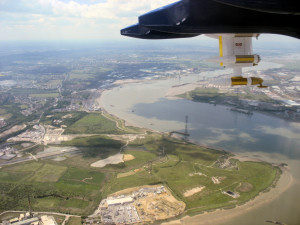ADIENT and EUCAARI-LONGREX Projects
ADIENT
The ADIENT project aims to reduce uncertainties in estimates of aerosol direct impacts on climate. Direct impacts include the scattering by aerosols of incoming solar radiation back to space and the absorption by aerosols of radiation. Our role in the campaign is to examine the chemical composition of aerosol over the UK under a variety of meteorological conditions from the FAAM BAe 146 research aircraft. Aerosol chemical composition and mixing state are characterised by an Aerodyne compact Time-of-Flight aerosol mass spectrometer and a Droplet Measurement Technologies Single Particle Soot Photometer. Our focus was evaluating the chemical evolution of aerosol on a variety of spatial scales and relating it to changes in aerosol optical and microphysical properties. We took part in 21 flights during ADIENT. Each flight targeted specific regions of the UK depending on the meteorological conditions. For example, during easterlies we flew upwind of the UK to examine pollution inflow to the UK from Europe; during westerlies we flew downwind of the UK to examine pollution originating in the UK. We also flew circuits around London, approximately following the path of the M25, to examine pollution transported in and out of London.
EUCAARI-LONGREX
The EUCAARI-LONGREX project was a series of coordinated research flights involving the FAAM BAe 146 and the Deutsches Zentrum fur Luft- und Raumfahrt (DLR) Falcon 20-E5 research aircraft. The aim of the campaign was to evaluate the climate impacts of aerosols over Europe with an emphasis on their relationship to long range transport processes. The 15 FAAM research flights during LONGREX covered a large spatial area, ranging from the western coast of Ireland to the boreal forests of Finland. A significant high-pressure system dominated the first week of the campaign, allowing for the repeated sampling of pollution as it circulated over Europe. This allowed us to examine the aging of the pollution as it travelled from east to west over Europe. The University of Manchester was responsible for measurements of aerosol composition, mixing state and cloud microphysical properties using a variety of instruments.
